|
The
|
||||||||||||||||||||||||||||||||||||||||||||||||||||||||||||||||||||||||||||||||||||||||||||||||||||||||||||
THE BURGENLAND BUNCH NEWS - No. 236 October 31, 2013, © 2013 by The Burgenland Bunch All rights reserved. Permission to copy excerpts granted if credit is provided. Editor: Thomas Steichen (email: tj.steichen@comcast.net) Our 17th Year. The Burgenland Bunch Newsletter is issued monthly online. It was founded by Gerald Berghold (who retired Summer 2008 and died in August 2008). |
||||||||||||||||||||||||||||||||||||||||||||||||||||||||||||||||||||||||||||||||||||||||||||||||||||||||||||
| Current Status Of The BB: * Members: 2193 * Surname Entries: 7276 * Query Board Entries: 5220 * Staff Members: 17 |
||||||||||||||||||||||||||||||||||||||||||||||||||||||||||||||||||||||||||||||||||||||||||||||||||||||||||||
This newsletter concerns: 1) THE PRESIDENT'S CORNER 2) HELPING OUT THE US GOVERNMENT 3) RAABA BATTHYÁN AND THE EISENBACH FAMILY 4) WHERE DID BURGENLÄNDERS LIVE IN VIENNA? 5) THE RIGHT OF DOMICILE 6) HISTORICAL BB NEWSLETTER ARTICLES: - REFORMATION SPARKED MANY MIGRATIONS TO BURGENLAND 7) ETHNIC EVENTS 8) BURGENLAND EMIGRANT OBITUARIES (courtesy of Bob Strauch) |
||||||||||||||||||||||||||||||||||||||||||||||||||||||||||||||||||||||||||||||||||||||||||||||||||||||||||||
1) THE PRESIDENT'S CORNER (by Tom Steichen)  After
the Bits and Pieces in my President's Corner below, we continue
with a Follow-up from almost a year ago when the BB Helped Out the US
Government. Enjoy the video the government produced with (a very little bit of) our
help. After
the Bits and Pieces in my President's Corner below, we continue
with a Follow-up from almost a year ago when the BB Helped Out the US
Government. Enjoy the video the government produced with (a very little bit of) our
help. Article 3 delves into a, so far, unidentified place... perhaps you recognize "Raaba Batthyán"? If so, drop me a note! Article 4 is another request for information, this time on Where Did (Your) Burgenländers Live in Vienna? Article 5 is our educational article of the month, delving into the Official Regulations surrounding Austrian Citizenship and the Right to Domicile. It also takes up a story I begin as "tidbit" 3 in my bits and pieces below, as the rest of that story is told by these types of issues. The remaining articles are our standard sections: Historical Newsletter Articles, and the Ethnic Events and Emigrant Obituaries sections. Unlike last newsletter, we actually have some Emigrant Obituaries to report this month. I start with some bits and pieces—"tidbits" by another name: 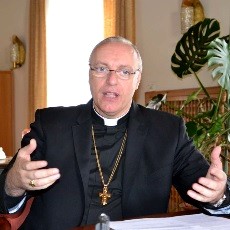 Visit
to North America by the Bishop of the Eisenstadt Diocese: Visit
to North America by the Bishop of the Eisenstadt Diocese: [Ed. note: I had intended to participate in the Lehigh Valley events for the recent visit of the Bishop and his delegation, however, a personal issue arose and I was not able to attend. Frank Paukowits did attend, both in New York and the Lehigh Valley, and graciously agreed to provide a report. Below are Frank's words.] Bishop Visits North America (by Frank Paukowits) Bishop Ägidius Zsifkovics and his delegation flew back to Austria on October 28, after a busy, eleven-day visit to three Burgenland enclaves in the United States and Canada (New York, Lehigh Valley in Pennsylvania and Toronto, Canada). From all perspectives, the trip was a rousing success. Participation was extensive, and the crowds were enthusiastic and moved by the Bishop’s warmth and intellect. His Excellency, who is 50 years of age, has been the Bishop of Eisenstadt for about three years. He was raised in Hackerberg, a town in southern Burgenland near Stinatz. He succeeded Bishop Iby, who retired in 2010. The events that were planned for the Bishop were both secular and religious. The mass at St. Peter’s Church in Coplay, PA, was particularly moving, and was a blended service in three different languages: German, English and Croatian. It was co-celebrated with Father Martin, the pastor of St. Peter’s. In the Bishop’s sermon, he stressed his connection with the immigrants from Burgenland, and how they came to their new homeland with three things: ”their faith, culture, and two hard-working hands.” He said he would remember them always in his prayers. The Bishop is a very charismatic figure. At each of the social events on the trip, he participated in song and dance, to everyone’s delight. Cameras were constantly flashing, as people looked to take a picture with their new-found friend. He was one of them, a Burgenländer, and a person to be admired. Much of the credit for organizing the trip rests with Walter Dujmovits. For the longest time, he has been the linchpin for maintaining relations between Burgenländers living in Austria and those who left their birth land for a better life elsewhere. May he continue through the Burgenländische Gemeinschaft to function in this role for many years to come. God bless. 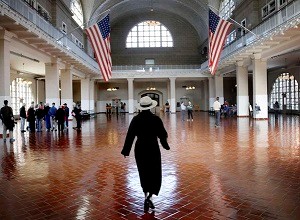 Ellis
Island Museum Reopens: Ellis Island, closed since hurricane Sandy hit on October 29, 2012,
reopened to visitors on Monday, October 28, 2013, a day short of a full year after the storm
hit. Ellis
Island Museum Reopens: Ellis Island, closed since hurricane Sandy hit on October 29, 2012,
reopened to visitors on Monday, October 28, 2013, a day short of a full year after the storm
hit. The grounds, main building and some of its exhibits are open, however, many of its photographs and artifacts are still in offsite storage and its on-site, public-use research computer systems have not yet been repaired or replaced. While the restoration is ahead of schedule, upgrades to sewage and electrical systems will not be completed until later this year. Restoration of full services is targeted for spring 2014. Total costs for restoring Liberty and Ellis islands are expected to approach $77 million. Hannes Graf has closed website "The Spirit of Gradisce, Örvidek Group": Last month, I reported that Hannes Graf had decided to close his Burgenland-related website, "The Spirit of Gradisce, Örvidek Group" (www.burgenland-bunch.org); that closure has now been completed. The material he donated to the BB currently can be found from links on the BB homepage under heading "Spirit of Gradišće - Őrvidék Group." Here are the groups of material: Father Graisy Book: Hannes' version (provides additional translations of "special pages") Burgenland Buildings: Articles about castles, churches, parks, etc. in Burgenland Burgenland Villages: Articles about villages in greater Burgenland Croatian History in Austria/Hungary: A translation of Burgenland-Croatian history material Burgenland Articles: Burgenland-related articles that do not fit elsewhere above While Hannes has shut down the above site, additional material from it has been placed on his surviving website, www.scholemandfriends.com. You may wish to check it out. As noted last month, when necessary, BB members should contact Hannes using email address hannes.graf@the-burgenland-bunch.org. Again, our thanks to Hannes for contributing material to the BB and for his continuing support and service to our membership. Gilly Surname in Burgenland: Last month I also wrote about my Ireland trip and various connections of Ireland to Burgenland. Among others, I said: "There is yet another connection too, as provided to me from Bob Strauch by Margaret Kaiser:
Looking through our BB houselist data, I see that the surname GILI was present in Neustift
bei Güssing during 1669-1699 and variations GILLI and GILLY were present in Kukmirn, Tobaj,
Heiligenkreuz and Deutsch Tschantschendorf in the 1850s houselists. The current Austrian
phonebook still yields 2 GILLI surnames in northern Burgenland and 10 GILLY surnames in
southern Burgenland."
Definitions:
So, Dennis and Marilyn (and your other recipe authors), on behalf of Bonnie and all of
us in the BB, thanks for sharing your wonderful recipes!
I had to smile at the "Oh, it is morning and now I am very hungry" line (her message was
time-stamped 8:12 am), but strudels can do that. |
||||||||||||||||||||||||||||||||||||||||||||||||||||||||||||||||||||||||||||||||||||||||||||||||||||||||||||
2) HELPING OUT THE US GOVERNMENT Back in November 2012 (see Newsletter 226, the seventh item in Article 1), I reported that the BB was requested by US Embassy staff members in Vienna to allow use of an image from our website. The Embassy staff said: "Next year, the U.S. Embassy will celebrate 175 years of US/Austrian diplomatic relations and, in this context, we are planning an exhibit, a video clip, a commemorative booklet as well as events throughout the year circling around this anniversary." I, of course, cooperated in their project and noted to you, our readership, that "I'll try to remember to see what the Embassy puts out next year and, if I do in fact check on that, I'll share it with you." In September this year I remembered to do so. Below is the ~18 minute video the Embassy produced. Also, a "commemorative booklet" (pdf) is found here: 175 years USA-Austria. The requested photo (originally from Mike Mittermann) appears in both the video and booklet and the BB is credited at the end of each. Both are nice summaries of US / Austrian relations and both recognize the large proportion of Burgenländers who emigrated to the US. In addition, there is an associated webpage: http://austria.usembassy.gov/175/intro.html. Click on the image below to start the video (the initial sequence in the video, where the US flag evolves into the Austrian flag, is a nice diplomatic touch!): 175 Years U.S.-Austrian Diplomatic Relations |
||||||||||||||||||||||||||||||||||||||||||||||||||||||||||||||||||||||||||||||||||||||||||||||||||||||||||||
3) RAABA BATTHYÁN AND THE EISENBACH FAMILY Albrecht Zimburg, on the GenTeam Austria List, writes:
Albrecht replied, expressing interest in taking up my offer of posting his
question:
Thus we have two questions for you, our readers: |
||||||||||||||||||||||||||||||||||||||||||||||||||||||||||||||||||||||||||||||||||||||||||||||||||||||||||||
4) WHERE DID BURGENLÄNDERS LIVE IN VIENNA? A common but still difficult "Burgenland" research problem occurs when family members went to Vienna and married there and/or had children born there. The difficulty arises because Vienna is a huge city, with many districts and many churches/synagogues/etc. within those districts. Too often, all the researcher knows is that the family members resided in "greater" Vienna, and not the specific area therein. Further, for those marrying there, the spouse may be from anywhere within the Austro-Hungarian Empire (or even beyond). Lastly, records are not as available for "Vienna" as they are for West Hungary. Although there were strong reasons to have vital events also recorded in the Burgenland church or civil registers, this was not always done and, even if done, the entry may appear many months or even years after the event. A case in point is the situation for recent new member, Corrine Bucher. Her grandfather (John) was apparently born in Vienna to Johann Ohr and "Mary" Richter (her first name is not known with certainty). Johann was from Markt Allhau but went to Vienna to work, where he met "Mary." Nature took its course and Corinne's grandfather was born in Vienna under the Richter name. Later, Johann took the boy back to Markt Allhau and married a different woman. However, no birth record (under either surname) appears in the Markt Allhau vital records. Unfortunately, Corrine does not know the location in Vienna where "Mary" and/or Johann lived. When John turned 19, he emigrated to Canada and later married. However, it is his stepmother's name that appears on his marriage record. Realistically, in most cases one must know where in Vienna the family lived to have any chance of finding the vital records of interest. Currently in Vienna, there are 167 Catholic churches (among 660 within the Vienna diocese), 22 Protestant churches, 10 Orthodox churches, 12 Jewish synagogues, 29 Muslim/Islamic mosques, and assorted other places of worship (Buddhist temples, etc.). I would assume that it is quite likely that there were more Catholic churches in the past than there now, largely due to overall reduced religious attendance and the resulting parish mergers. One positive in all this is that the Vienna Catholic Diocese has placed digital images online of church registers for many parishes at http://matricula-online.eu/?lang=en. If one is researching Catholic family members, and can narrow down the possible parishes, visually scanning these images is possible. So that gets me to my question for you: were there specific areas of Vienna where Burgenländers tended to settle, even if temporarily? If we are able to reduce the number of parishes to review, we can increase the likelihood of assisting BB members with this type of research problem. Thus, if you know a specific address, or even the district, within Vienna that your Burgenländers lived at please send that info to me. If enough people respond, perhaps we can see a pattern in the settlement of Burgenländers within Vienna. For reference, below is a (previously published) listing of the Districts of Vienna, along with an overview map of where they are. As surrounding villages were absorbed as Vienna city expanded, some village names changed or disappeared and others gave their names to today's districts. The listing below shows the current district name plus the prior areas/entities within them. [Ed: One should note that if you have the postal code, you can identify the district. For Vienna, the second and third digits of the Austrian postal code denotes the district (all Vienna postal codes begin with 1). Thus 1010 is the postal code for the Innere Stadt (district 01) of Vienna; 1230 represents district 23 (Liesing).] The Viennese Districts and the Residential Area Names. Format: Number. Name: Former Place Names (%, if split); [Unofficial Names] 1. Innere Stadt 2. Leopoldstadt: Leopoldstadt, Unterer Werd, Jägerzeile, Prater 3. Landstraße: Landstraße, Erdberg, Weißgerber; [St. Marx, Belvedere, am Modenapark] 4. Wieden: Wieden, Hungelbrunn, Schaumburgergrund 5. Margareten: Margareten, Nikolsdorf, Matzleinsdorf, Laurenzergrund, Reinprechtsdorf, Hundsturm 6. Mariahilf: Mariahilf, Gumpendorf, Magdalenengrund, Laimgrube, Windmühle 7. Neubau: St. Ulrich (90%), Neustift, Schottenfeld, Spittelberg, Laimgrube, Alt-Lerchenfeld (10%) 8. Josefstadt: Josefstadt, Strozzigrund, Breitenfeld, Alt-Lerchenfeld (90%), St. Ulrich (10%), Alservorstadt (10%) 9. Alsergrund: Alservorstadt (90%), Michelbeuern, Himmelpfortgrund, Li(e)chtental, Althan, Am Thury, Roßau 10. Favoriten: Favoriten, Oberlaa, Unterlaa, Rothneusiedl, Inzersdorf (50%); [Wienerberg, Laaer Berg] 11. Simmering: Simmering, [Kaiser-]Ebersdorf, Albern, Neu-Albern, Kledering (1%); [Simmeringer Haide] 12. Meidling: Meidling, Wilhelmsdorf, Gaudenzdorf, Altmannsdorf, Hetzendorf; [Am Schöpfwerk] 13. Hietzing: Hietzing, Unter St. Veit, Ober St. Veit, Hacking, Lainz, Speising; [Schöönbrunn, Friedensstadt, Roter Berg] 14. Penzing: Penzing, Breitensee, Unter-Baumgarten, Ober-Baumgarten, Hütteldorf, Hadersdorf, Weidlingau, Hainbach, Hinterhainbach, Steinbach (50%); [Wolfersberg, Hüttelberg, Steinhof] 15. Rudolfsheim-Fünfhaus: Reindorf, Rustendorf, Braunhirschengrund, Fünfhaus, Neu-Fünfhaus, Sechshaus; [Auf der Schmelz] 16. Ottakring: Ottakring, Neulerchenfeld; [Wilhelminenberg] 17. Hernals: Hernals, Dornbach, Neuwaldegg 18. Währing: Währing, Weinhaus, Gersthof, Pötzleinsdorf; [Schafberg] 19. Döbling: Heiligenstadt, Ober-Döbling, Unter-Döbling, Nußdorf, Josefsdorf, Kahlenbergerdorf, Grinzing, Ober-Sievering, Unter-Sievering, Salmannsdorf, Neustift am Walde 20. Brigittenau: Brigittenau, Zwischenbrücken; [Am Sporn] 21. Floridsdorf: Floridsdorf, Jedlesee, Großjedlersdorf, Neujedlersdorf, Leopoldau, Donaufeld, Strebersdorf, Stammersdorf; [Mühlschüttel, Schwarzlackenau] 22. Donaustadt: Stadlau, Eßling, Kagran, Aspern, Hirschstetten, Kaisermühlen, Breitenlee, Süßenbrunn, Neueßling, Neukagran; [Gänsehäufel, Neuhaufen, Schafflerhof, Mühlau, Heustadlmais, Biberhaufen, Schierlinggrund] 23. Liesing: Liesing, Atzgersdorf, Mauer, Rodaun, Erlaa, Alt-Erlaa, Neu-Erlaa, Inzersdorf (50%), Kalksburg, Siebenhirten; [Kadoltsberg, Rosenhügel, Steinsee, Neustift oder Straßenhäuser, Neu-Steinhof] Bibliography: Stadtchronik Wien, 1986, Verlag Christian Brandstätter [Ed Note: some prior places were either split between districts or were not fully incorporated into the province and the city.] 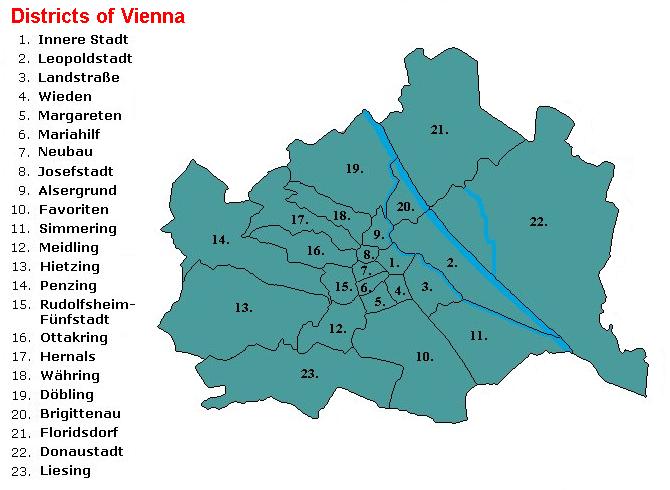
|
||||||||||||||||||||||||||||||||||||||||||||||||||||||||||||||||||||||||||||||||||||||||||||||||||||||||||||
5) THE RIGHT OF DOMICILE Margaret Kaiser passed along a (German language) question and answer, found on the "GenTeam Austria" mailing list, that she felt was applicable to our understanding of Burgenland records and that also contained a couple of links worth noting. In particular, a GenTeam Austria list member (Frank Fleissner) wrote that he found a phrase in a birth entry (in a church book from the Bohemian Forest area along the national border of the Czech Republic with Germany and Austria) that he needed help in understanding. The phrase was "dahin zuständig" and it appeared next to the birth mother's name in the entries for illegitimate births. I'll note that the phrase translates to "there responsible" or "to that place responsible." The reply message (by Martin Aigner) concentrated only on the word "zuständig" and the meaning of "responsible" in this context. Martin wrote (in part) that "responsible" meant that "the mother had the right of domicile in the village" and, therefore, that the community of birth was also responsible for recording this illegitimate birth in its register. Further, Martin explained that "Marital children acquire the right of residence in that municipality in which the father held home rights at the time of their birth," However, "illegitimate children are entitled to home rights in the community in which the mother has the right of domicile at the time of their birth." Martin also noted that "Therefore, it was quite possible that people were born in places where they did not have the right of residence and therefore the birth entry is not found in the local book of births, but in the place where the parents had the right of domicile." He also indicated one could read more at: http://www.demokratiezentrum.org/wissen/timelines/entwicklung-der-staatsbuergerschaft.html http://de.wikipedia.org/wiki/Österreichische_Staatsbürgerschaft Both of the above are German-language websites. The first is titled "Development of Citizenship in Austria" and gives a timeline history of citizenship rights and the related "home rights" / "right of domicile" in Austria and the prior Austro-Hungarian Empire. The second, titled "Austrian Citizenship," concentrates mostly on post-1984 citizenship regulations, with only a short historical section. Given our interest in the older, historical rules, I'll provide a summary of the material from the first link only. In addition, although this first webpage addresses citizenship regulations into the current day, I will stop my summary at 1925, as the WW-II Anschluss-induced changes and later restitutions and additions are complex and largely inapplicable to our emigrant forebears. Here is what the first webpage says: 1786: In Emperor Joseph II's law books (patent of November 1, 1786) there appears, for the first time, a distinction between "subjects" and "strangers". 1804: The Conscription and Recruitment patent of 25 October speaks of "locals" and "foreigners" (with regard to the preservation of the army). This law forms the initial basis for later law provisions concerning homeland and community affiliation. 1812: For the first time in the Civil Code there is a uniform regulation that includes the term "citizenship" but is, by no means, a citizenship law in the strict sense. Although it applies to all "German dominions" of the monarchy, the meaning of citizenship is limited. Instead, it is closely linked with regulations regarding emigration and is considered a precondition for obtaining the "home right" in the community, which is of far greater importance. 1849: The provisional Community Law forms the basis for subsequent regulation of Homeland rights. A distinction is made between "community members" and "strangers," wherein community members are either citizens or dependents and relatives of those citizens. However, all who are recognized (by birth or admission to the municipality by the local authorities) as current or permanent residents or property owners "...shall pay a certain amount per year in direct taxes." 1859: Municipalities Act of 1859 includes, for the first time, the term "Heimatrecht" (home rights / right of domicile / right to residency). 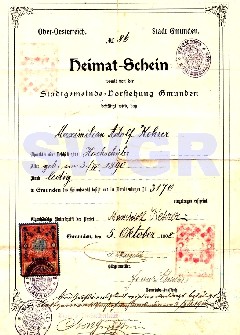 1863:
In the Heimatrechtsgesetz (Home Rights Act), the home town is declared responsible for keeping
a record of community members (a "home roll") and for the issuance of home rights certificates
(Heimatschein: certificate of origin). People who were not already registered in the
membership of a Catholic parish (Pfarrmatrikel), were recorded in a civil register (Zivilmatrik)
in 1870. Home rights (right of domicile) is based on the principle of descent and can be
obtained only by Austrian citizens. The Act declares that every citizen shall have the right
of domicile in an Austrian community, the right to an undisturbed stay in the home community,
and community poverty relief (the Act was also the precursor to a formal right to vote).
Further, home rights are acquired by birth, marriage, admission to the home association or
public office, and by "adverse possession" (living in a Crownland for at least ten years [and
later four years]). It is also noted therein that women gain through marriage a right of
domicile/citizenship in the home community of her spouse. This is also the Law that Martin
Aigner cites above concerning the differing home rights for legitimate and illegitimate
children. 1863:
In the Heimatrechtsgesetz (Home Rights Act), the home town is declared responsible for keeping
a record of community members (a "home roll") and for the issuance of home rights certificates
(Heimatschein: certificate of origin). People who were not already registered in the
membership of a Catholic parish (Pfarrmatrikel), were recorded in a civil register (Zivilmatrik)
in 1870. Home rights (right of domicile) is based on the principle of descent and can be
obtained only by Austrian citizens. The Act declares that every citizen shall have the right
of domicile in an Austrian community, the right to an undisturbed stay in the home community,
and community poverty relief (the Act was also the precursor to a formal right to vote).
Further, home rights are acquired by birth, marriage, admission to the home association or
public office, and by "adverse possession" (living in a Crownland for at least ten years [and
later four years]). It is also noted therein that women gain through marriage a right of
domicile/citizenship in the home community of her spouse. This is also the Law that Martin
Aigner cites above concerning the differing home rights for legitimate and illegitimate
children.1867: The Basic Law is the first constitutional law governing questions of citizenship. The three main provisions are that 1) for all people in the Imperial kingdoms and countries, there is a general Austrian citizenship law; 2) that before the law, all citizens are equal; and 3) that public offices are equally accessible to all citizens. However, for foreigners, such rights are dependent upon acquisition of Austrian citizenship. 1869: A minimum of ten years of residence and possession of citizenship is a condition for receiving a "right of domicile". 1918: After the collapse of the Austro-Hungarian Empire, the German-Austrian Republic is proclaimed with a provisional constitution and on 5 December 1918, a corresponding German-Austrian citizenship law is promulgated that says that all persons who were entitled to home rights in a community that is now in the German-Austrian Republic are immediately awarded German-Austrian citizenship and rights. In addition, people who were resident in Vienna since 1914, can apply for and obtain citizenship. Further, refugees who had home rights in Austrian areas not in the new German-Austrian Republic and, therefore, lost their prior Austrian citizenship, also can (during a one-year period) apply for and obtain citizenship. (This last provision sparked verbal outbursts, especially against allowing citizenship to Jewish war refugees.) 1920: The Austrian Federal Constitution is adopted, with citizenship legislation being a federal matter and implementation a state matter. There are both a federal and a state citizenship, with the prerequisite being home rights in a community in the country. 1925: With the Right of Domicile amendment in 1925, control of such rights are transferred to the federal constitution. 1925: The citizenship law is enacted, regulating both state and federal citizenship. Citizenship is acquired by birth, by ceremony with a minimum of four years' residence, by marriage (married women automatically get citizenship as "appendages" of their husbands) and by the start of a public teaching job in a domestic university. So, much as Fritz Königshofer has been trying to teach us, this "right of domicile" was an important right, was well-regulated, and conferred many privileges. Establishing a record of the right was essential and valuable. As you can see however, the place of birth was not the controlling factor in where a child held rights. Rather, the place where the relevant parent had rights determined where a child held rights. Likewise, the location for home rights of a wife was determined by those of the husband. Be sure to keep these rules in mind when you search for the location recording a birth or marriage. It is here that I take up again the story of Caecilia Gibiser (presented in Article 1 above as the 3rd "tidbit") and the documents that Peter Bach shared. The additional "twist" that I mentioned in Article 1 can be best addressed by the note I sent to Peter after reading the birth extract copy. I wrote (in part):
|
||||||||||||||||||||||||||||||||||||||||||||||||||||||||||||||||||||||||||||||||||||||||||||||||||||||||||||
6) HISTORICAL BB NEWSLETTER ARTICLES Editor: This is part of our series designed to recycle interesting articles from the BB Newsletters of 10 years ago. This month, I reprint one from Newsletter No. 122C (October 30, 2003), as it covers (sort of) a topic of interest to me... when and where from did peoples migrate to what is now Burgenland. In this article, Gerry Berghold addresses one of the motivating factors: religious intolerance in the form of the Reformation and counter-Reformation. THE BURGENLAND BUNCH NEWS No. 122C October 31, 2003 REFORMATION SPARKED MANY MIGRATIONS TO BURGENLAND 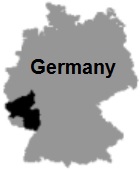 Last
Sunday was Reformation Sunday and I couldn't help but reflect on the many changes caused by
the Reformation and Counter Reformation. Subsequent war and intolerance, followed by famine,
plague and economic disaster, devastated most of Europe; much emigration followed. The ripple
effect extended well into the last century and may still be with us. As we read those
wonderful LDS microfilms of Burgenland parishes, we can see the changes that took place.
Catholic records at first, then Lutheran and Calvinist, then Catholic again, followed by both.
Those of you with Palatinate ancestors (so-called Pennsylvania Dutch—my wife's people) may not
know that the first religious migration for this large group was from Switzerland to the
Palatinate (Rhine-Hesse today) and then to America, following a serious of devastating wars. Last
Sunday was Reformation Sunday and I couldn't help but reflect on the many changes caused by
the Reformation and Counter Reformation. Subsequent war and intolerance, followed by famine,
plague and economic disaster, devastated most of Europe; much emigration followed. The ripple
effect extended well into the last century and may still be with us. As we read those
wonderful LDS microfilms of Burgenland parishes, we can see the changes that took place.
Catholic records at first, then Lutheran and Calvinist, then Catholic again, followed by both.
Those of you with Palatinate ancestors (so-called Pennsylvania Dutch—my wife's people) may not
know that the first religious migration for this large group was from Switzerland to the
Palatinate (Rhine-Hesse today) and then to America, following a serious of devastating wars.Relative to Burgenland family history, there were some good factors. I doubt if the Council of Trent, 1545-63, would have been held if Martin Luther hadn't begun the Reformation. From that council, we received church records and surnames. Everyone had to take a surname to facilitate record keeping, and parish priests were required to record baptisms. Marriage and death records followed. The down-side was that the council also agreed that "he who rules decides religion," and intolerance followed. Subjects had to follow the religion of their rulers—or leave their homes. Many changed but many opted to migrate. I know that the Lutherans (Evangelicals) in southern Burgenland migrated from Catholic Styria and Lower Austria, perhaps even from Catholic Swabia and Bavaria.  Even
though local aristocracy could grant asylum (as the Batthyány did in southern Burgenland in
the Herrschaft of Güssing), Protestant churches were forbidden until after the Edict of
Toleration was passed in the 1700's. Lutheran churches were taken over and records seized. (A
few years ago, I examined one of the first Martin Luther bibles printed in German in the rare
book room of the Franciscan Cloister in Güssing. I saw many other Protestant books that had
been taken from Protestant churches in the area.) This is why many Lutheran church records do
not start until 1720, although the Turkish Wars also destroyed many. Even
though local aristocracy could grant asylum (as the Batthyány did in southern Burgenland in
the Herrschaft of Güssing), Protestant churches were forbidden until after the Edict of
Toleration was passed in the 1700's. Lutheran churches were taken over and records seized. (A
few years ago, I examined one of the first Martin Luther bibles printed in German in the rare
book room of the Franciscan Cloister in Güssing. I saw many other Protestant books that had
been taken from Protestant churches in the area.) This is why many Lutheran church records do
not start until 1720, although the Turkish Wars also destroyed many. The Catholics were not alone in fomenting intolerance, Catholics in Protestant areas also had to change or migrate. The region that was Czechoslovakia stayed heavily Protestant, and Catholics had a hard time. Among the worst excesses were those promoted by the Bishop of Salzburg—Protestants either changed or left, abandoning all of their property. Children were forcibly taken from their families and given to others. Many Protestant Salzburgers ultimately migrated to Georgia and South Carolina, where their descendants may still be found today. Swedish Protestants committed terrible atrocities  during
the 30 Years War (see previous newsletters) as did their Catholic counterparts. One can still
see ruined castles, destroyed by French Catholic armies, in what was primarily Protestant
Rhineland. during
the 30 Years War (see previous newsletters) as did their Catholic counterparts. One can still
see ruined castles, destroyed by French Catholic armies, in what was primarily Protestant
Rhineland.The question arises, if we hadn't had the Reformation, would we have had the many migrations that subsequently took place? If you're looking for the origin of your family, it might be well to follow the religious record trail. I know the Counter Reformation caused my ancestors to migrate to Hungary from Styria. Would I have been born in America if they hadn't? These were bad times, but last Sunday, in our large Grace Lutheran Church in Winchester, a Catholic Priest officiated and delivered the sermon for the first time since the church was built in the 1700's. We are coming full circle—slowly but surely—and God must be smiling. |
||||||||||||||||||||||||||||||||||||||||||||||||||||||||||||||||||||||||||||||||||||||||||||||||||||||||||||
7) ETHNIC EVENTS LEHIGH VALLEY, PA Saturday, Nov 9, 7:30-11:30 pm: Military Ball. Lancaster Leiderkranz ($10 / $12 Guests). Music by the George Tarasek Orchestra. Info: www.lancasterliederkranz.com NEW BRITAIN, CT Friday, Nov. 1, 7 pm: Heimat Abend. Austrian Donau Club, 545 Arch Street, New Britain, CT (860 223-9401). Music by Joe Rogers. Friday, Nov. 15, 7 pm: Heurigan Abend. Austrian Donau Club. Music by Schachtelgebirger Musikanten. |
||||||||||||||||||||||||||||||||||||||||||||||||||||||||||||||||||||||||||||||||||||||||||||||||||||||||||||
8) BURGENLAND EMIGRANT OBITUARIES (courtesy of Bob Strauch) Theresia Menconi  Theresia
Menconi (née Augustin), 89, of Clifton, New Jersey, died October 12, 2013. Theresia
Menconi (née Augustin), 89, of Clifton, New Jersey, died October 12, 2013.Born in Punitz, Burgenland, Austria, Mrs. Menconi came to the United States in 1948, first settling in Passaic before moving to Clifton. She was a homemaker and nurturing caregiver to her family and friends. Surviving are her loving daughter, Marylou Menconi of Whippany, NJ; a sister, Maria Buczok of Highland Lakes; her granddaughter, Annamaria Menconi of Clifton and several nieces and nephews. Private Services were held under the supervision of Bizub-Quinlan Funeral Home, 515 Lexington Ave., Clifton. Visit www.bizub.com to leave online condolences. Published in The Record/Herald News on Oct. 15, 2013 Gisela Urban  Gisela
Urban, 98, of Allentown, Pennsylvania, passed away Oct. 23, 2013 at Cedarbrook Nursing Home. Gisela
Urban, 98, of Allentown, Pennsylvania, passed away Oct. 23, 2013 at Cedarbrook Nursing Home.Born in Rábafüzes (Raabfidisch) Hungary, she was a daughter of the late Josef and Gisela (Gollinger) Stanko. She was the wife of the late Edward Urban for over 57 years until his death in 1992. She was a member of Sacred Heart Roman Catholic Church and the Austrian-Hungarian Veterans Society Ladies Auxiliary. She was a sewing machine operator at various textile mills. Survivors: Daughters, Margaret Roma and Elfriede Seibert; sisters, Paula, Cecelia, and Frieda; 10 grandchildren; 16 great-grandchildren; three great-great-grandchildren; many nieces, nephews, other relatives and friends. Stella was predeceased by a daughter, Gisela Lutzenberger; a son, Edward; two sisters, Annette and Bertha; and four brothers, Joseph, Albert, Edward and Frank. Services: 10 a.m., Mon., October 28, 2013 at Weber Funeral Home, 1619 Hamilton St., Allentown, PA. Viewing: 8:30 a.m., Monday until time of services at the funeral home. (www.weberfuneralhomes.com) Contributions: In lieu of flowers, to Cedar Crest Bible Fellowship Church, 1151 S. Cedar Crest Blvd., Allentown, PA 18103 for Missions. Published in Morning Call on Oct. 25, 2013 |
||||||||||||||||||||||||||||||||||||||||||||||||||||||||||||||||||||||||||||||||||||||||||||||||||||||||||||
END OF NEWSLETTER |
||||||||||||||||||||||||||||||||||||||||||||||||||||||||||||||||||||||||||||||||||||||||||||||||||||||||||||
NOTICE (Terms and Conditions): The Burgenland Bunch (BB) was formed and exists to assist Burgenland descendants in their research into their heritage and, toward that end, reserves the right to use any communication you have with us (email, letter, phone conversation, etc.) as part of our information exchange and educational research efforts. • If you do not want your communication to be used for this purpose, indicate that it is "confidential" and we will abide by that request. • Correspondents who communicate with the BB without requesting confidentiality retain their copyright but give a non-exclusive license to the BB allowing us to forward to BB members, publish in our monthly newsletter or on our website, and/or subsequently and permanently archive all or parts of such communications. The Burgenland Bunch homepage (website) can be found at: http://www.the-burgenland-bunch.org/ Burgenland Bunch Newsletter, copyright © 2013 by The Burgenland Bunch All rights reserved. Permission to copy excerpts granted if credit is provided. |
||||||||||||||||||||||||||||||||||||||||||||||||||||||||||||||||||||||||||||||||||||||||||||||||||||||||||||
 News
News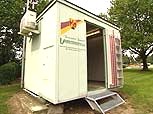 Burgenland
Air Quality: The Burgenland government automatically posts new air quality reading
every half hour to page
Burgenland
Air Quality: The Burgenland government automatically posts new air quality reading
every half hour to page 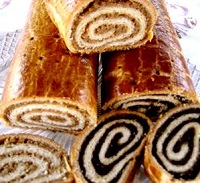 Prepare
dough: Stir sugar, salt, and 1/4 cup butter into hot milk. Cook to lukewarm. Sprinkle
yeast over warm water in large bowl; stir to dissolve. Stir in lukewarm milk mixture; add 2
eggs and 2 1/2 cup flour. Beat at high speed with electric mixer 2 minutes. With wooden spoon
gradually beat in remaining 2 cups flour. Knead with hand until the dough is stiff enough to
leave the side of bowl. Place dough in lightly greased large bowl. Turn dough over to bring
greased side up; cover with towel. Let rise in warm place (85° F.) free from drafts until
double in bulk - about 1 hour.
Prepare
dough: Stir sugar, salt, and 1/4 cup butter into hot milk. Cook to lukewarm. Sprinkle
yeast over warm water in large bowl; stir to dissolve. Stir in lukewarm milk mixture; add 2
eggs and 2 1/2 cup flour. Beat at high speed with electric mixer 2 minutes. With wooden spoon
gradually beat in remaining 2 cups flour. Knead with hand until the dough is stiff enough to
leave the side of bowl. Place dough in lightly greased large bowl. Turn dough over to bring
greased side up; cover with towel. Let rise in warm place (85° F.) free from drafts until
double in bulk - about 1 hour.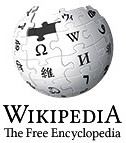 Genealogical
Tidbit of the Month:
Genealogical
Tidbit of the Month: 
 As
for the place “Rababattyan” near Sávár found via link
As
for the place “Rababattyan” near Sávár found via link